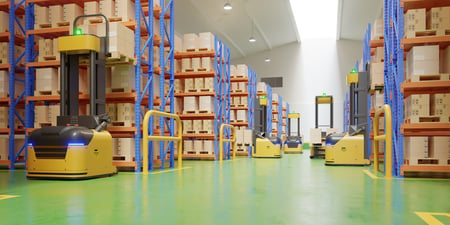 What Are AGVs?
What Are AGVs?
Automated Guided Vehicles (AGVs) are otherwise known as battery-powered driverless vehicles. Some people think of them as simple machines that do tasks instead of human personnel.
But there’s a lot more to AGVs than that. In fact, more and more commonly, AGVs are becoming an integral part of the automated manufacturing landscape. That’s because AGVs are able to automate a number of previously manual tasks, with efficiency and accuracy going up and costs and errors going down.
AGVs aren’t just utilized in distribution and manufacturing -- you can also find them in industries such as healthcare, retail, and the military. That’s because of their numerous potential time, cost, and labor-saving applications, such as:
- Raw material storage
- Finished good storage
- Assembly operations
- Flexible manufacturing systems
- Manufacturing operations
And as technology continues to improve, more and more applications are being developed every day.
With that in mind, let’s take a look at the advantages and pitfalls of AGVs to help you determine if they are right for you, your industry, and your operations.
AGV Advantages
Reduced Labor Costs
Reduced labor costs are one of the primary advantages of AGVs. In short, machines cost less to buy than a human does to hire. When you hire a new worker, you aren’t just committing to paying their salary: you also have to manage their health care coverage, payroll taxes, salary increases, vacation and sick time, and more. With an AGV, you aren’t responsible for any costs beyond the purchase and maintenance of the equipment.
Increased Safety
AGVs are programmed for safety, with equipment such as cameras, lasers, and sensors all built-in to ensure that AGVs can operate safely around personnel and equipment. Equipment run by human operators have far fewer safety mechanisms. And no matter how many safety trainings your employees go through, there’s no getting around the possibility of human error. From fatigue to simple distraction, human error always can and always will happen. Another benefit of AGVs is that they can operate in dangerous or extreme work environments that are unsafe for humans.
Easy to Phase In
It’s easy to slowly phase AGVs into your operations. Not only can AGV systems be installed in existing buildings with minimum interference to ongoing operations, but they also can typically be installed in far less time than most other material handling systems. And as your operations expand, it’s simple to add more AGVs as they become necessary; it doesn’t need to happen all at once. This allows you to avoid an overwhelmingly high initial investment, and instead, phase in one or two AGVs at a time, slowly expanding your fleet at a pace that meets your needs.
AGV Disadvantages
However, despite the advantages many AGVs offer, there are also disadvantages and pitfalls to consider.
High Initial Investment
While purchasing an AGV is financially advantageous -- it’s cheaper than the long-term costs of hiring an employee and increases productivity -- the initial costs can be steep. While an AGV will save you costs in the long run, in the short-term, the purchase of an AGV is simply more expensive than hiring a new employee. This could be a concern for smaller operations without ready access to capital. Consider lease-to-own or Robotics-as-a-Service financing options to reduce the upfront capital payments required. You may also want to consider a bundled equipment + maintenance package with uptime commitments built into the monthly payment.
Maintenance and Training Costs
While it’s true that AGVs do not require health insurance or vacation days, you do need to account and plan for their maintenance costs. Just like with any equipment, AGVs will require regular maintenance and occasional repairs. Consider a two-step maintenance program—your team does PMs and simple maintenance and the AGV company provides tier 2/engineer-led maintenance. Or outsource it completely. Ask yourself how dependent your operation will be on these AGVs and whether you’ll have equipment redundancy. If not, consider having someone onsite full-time from the vendor or ensure a vendor contract has a Service Level Agreement (SLA) that guarantees a technician to your facility within several hours. Initially, this will likely lead to some downtime to train the maintenance staff and implement the AGVs. While these costs are not strictly a disadvantage -- they may still be lower than the long-term costs incurred by an employee -- they are something to account for in budgeting and planning.
Loss of Flexibility
AGVs don’t offer much in the way of flexibility. They operate according to strict preset systems and processes, so they can’t easily adapt to new needs that fall outside this scope. That’s good news when it comes to efficiency, reliability, and safety. But if you work in an agile, flexible industry that has to be able to rapidly react to changes or trends, then an AGV may not be the best fit.
Limited to Repetitive Tasks
AGVs are great at completing repetitive tasks. However, if your industry deals with non-repetitive tasks or your appetite to change/improve processes often is growing, then human personnel operating machinery and/or other automation options like co-bots/AMRs may be a better choice.
AGVs have very real advantages and applications for a growing number of industries and their acquisition costs/effectiveness for certain processes have come down over time. If you find vendors with clear ROIs, shorter-term paybacks and lots of proven customer experiences validating these items, AGVs can be the way to go.
In terms of applications that are a good fit for AGVs, the options grow every day. We’ve seen customers with consistent carrying or production processes that involve significant movement of heavy products like beverages, canned food and paper products be ripe for AGVs. Other possibilities include more dangerous processes or those with more extreme hot/cold temperatures. AGVs that simply automate an existing forklift are exciting because they don’t require you to buy a different piece of equipment than your operators currently use. When you start talking about automated forklifts, the applications extend to tow tuggers carrying long trains of parts to an assembly line for automotive or heavy equipment manufacturing processes. Plus, more and more, you are seeing these in warehouses on sitdowns or reach trucks to carry product back and forth.
While AGVs or automating existing forklift equipment represents a significant financial investment, they may still benefit your operation in terms of increased uptime and long-term, overall cost savings. Just remember to ask how their AGVs are powered. We’ve been called into operations running AGVs with an automated process, inclusive of charging and PMs many times, but within 18-24 months, the power system is shot as the batteries are cooked. That means we’ve had to revamp the power system. That’s because the system was optimized for the processes needed, but the power system setup was an afterthought.
We can help you and your AGV vendor fix that on the front end and ensure it doesn’t happen. And yes, it starts with a Power & Operational Assessment, just like designing an AGV process should!
If AGVs aren’t right for you, but you want to automate your operation, there are many other options available to you, like AMRs (Autonomous Mobile Robots). You can find out more in our recent blog on the topic.
What’s most important is to understand your operation’s specific needs so you can tailor any material handling purchases to maximize your uptime. And, remember, if you’re unsure, you can always start small to test how automation works for your needs before expanding.


 Ryan Lynch
Ryan Lynch
